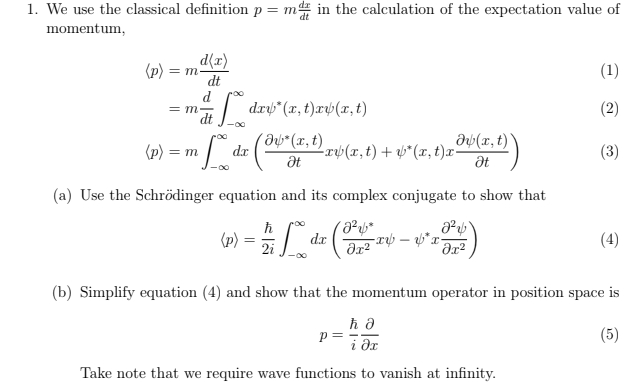1. We use the classical definition p= m in the calculation of the expectation value of momentum, d{r) = m dt (p) (1) =| dry*(x, t)xp(x,t) (2) = m ( Ənb* (x, t) Əb(x, t) (p) = m dr ( rv(x,t) + v*(x, t)= (3) (a) Use the Schrödinger equation and its complex conjugate to show that (p) d.x (4) 2i (b) Simplify equation (4) and show that the momentum operator in position space is p = (5) i dr Take note that we require wave functions to vanish at infinity.
1. We use the classical definition p= m in the calculation of the expectation value of momentum, d{r) = m dt (p) (1) =| dry*(x, t)xp(x,t) (2) = m ( Ənb* (x, t) Əb(x, t) (p) = m dr ( rv(x,t) + v*(x, t)= (3) (a) Use the Schrödinger equation and its complex conjugate to show that (p) d.x (4) 2i (b) Simplify equation (4) and show that the momentum operator in position space is p = (5) i dr Take note that we require wave functions to vanish at infinity.
Related questions
Question
Step by step process and explanation

Transcribed Image Text:1. We use the classical definition p= m in the calculation of the expectation value of
momentum,
d{r)
= m
dt
(p)
(1)
=| dry*(x, t)xp(x,t)
(2)
= m
( Ənb* (x, t)
Əb(x, t)
(p) = m dr ( rv(x,t) + v*(x, t)=
(3)
(a) Use the Schrödinger equation and its complex conjugate to show that
(p)
d.x
(4)
2i
(b) Simplify equation (4) and show that the momentum operator in position space is
p =
(5)
i dr
Take note that we require wave functions to vanish at infinity.
Expert Solution
This question has been solved!
Explore an expertly crafted, step-by-step solution for a thorough understanding of key concepts.
Step by step
Solved in 2 steps with 2 images
